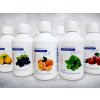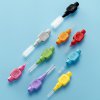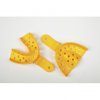Colourflow/Flow-Color is a modern, light-cured flowable composite that has been developed for the youngest dental patients and is used for sealing deciduous and permanent teeth.
Available in 9 vivid and cheerful colours to delight the youngest patients.
The product is available in syringes with luer-lock cap containing 1 g of preparation (in the colour of your choice) + applicator set.
Packages:
1 x 1 g
| Category: | Composite flow |
|---|
Properties:
- Colours available:

- Medical device class IIa.
- A flowable polymer dental material type 1 (class 2, group 1).
- Meets the requirements of the ISO 4049 standard.
- Undergoes free radical polymerisation activated by visible light from the blue region (400-500 nm).
- Has radio-opacity equivalent to 4-5 mm of aluminium (aluminium has radio-opacity equivalent to that of dentine; thus 1 mm of material having radio-opacity equivalent to 1 mm of aluminium has radio-opacity equivalent to that of dentine and 2 mm of aluminium is equivalent to enamel).
- In 2011, the Flow-Color composite won the CEDE Grand Prix award.
Indications for use:
- Black’s class I, II, III, IV and V cavities.
- Sealing of pits, fissures and cavities in deciduous and permanent teeth
- First contrasting composite layer in the case of temporary restorations
- Marking root canal orifices after endodontic treatment
Method of use:
Filling cavities in deciduous and permanent teeth:

Etch using etchgel, rinse and gently dry the surface (A). Thoroughly cover the surface with a thin layer of a bonding system, blow off the excess and polymerise (B).
In the case of very deep cavities cover the cavity bottom with a thin layer of liner and then apply layers of Colourflow composite (approx. 1 mm thick).
Cure each layer (C) in accordance with the polymerisation table provided. Cure in sections not longer than 5 mm at a time! Adjust to the bite and polish.
Sealing:

Etch using Etchgel, rinse and gently dry the surface (A). Thoroughly cover the surface with a thin layer of a bonding system (B), blow off the excess and polymerise.
Apply thin layers of Colourfloe flowable composite (approx. 1 mm). Cure each layer (C) in accordance with the polymerisation table. Cure in sections not longer than 5 mm at a time.
Root canal marking:

It is advised to use Colourflow composite to mark different conditions of root canals in order to facilitate diagnosis during subsequent treatment.
First contrasting composite layer in the case of temporary restorations:
Temporary splints:

Etch and apply a bonding system (such as Bond) in accordance with the instructions. Apply a small amount of Colourflow on the teeth intended for splinting and cure each tooth separately in accordance with the polymerisation table. The layer of Colourflow should be clearly visible to enable an easy distinction between the dentine and the composite which is later to be removed together with the fibre used for splinting.
Do not use Colourflow black and red as the first composite layer in the case of temporary splinting.

Temporary occlusal corrections and maintenance of interdental spaces.
Polymerisation table:

Attention! Do not use halogen lamps for the polymerisation of Colourflow red and black!
Polymerise Colourflow red and black in thin layers, not thicker than 1 mm.















